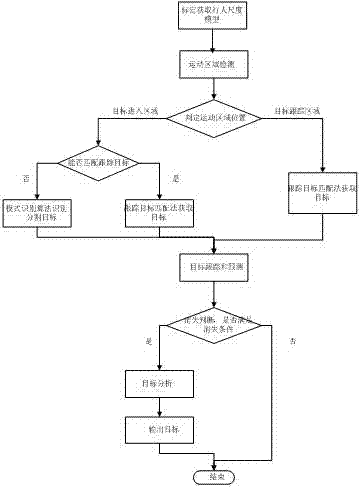Road pedestrian and non-motor vehicle detection method based on video analysis
A non-motor vehicle and video analysis technology, which is applied in image analysis, computer parts, image data processing, etc., can solve problems such as inability to meet real-time requirements, low detection accuracy of video images, and inability to detect pedestrians and non-motor vehicles. Achieve the effects of reducing computational complexity, improving detection efficiency and accuracy, and fast calculation speed
- Summary
- Abstract
- Description
- Claims
- Application Information
AI Technical Summary
Problems solved by technology
Method used
Image
Examples
Embodiment 1
[0065] Embodiment one, see figure 1 As shown, the present embodiment provides a method for detecting road pedestrians and non-motor vehicles based on video analysis, including:
[0066] Set the detection area step, and divide the detection area into a target entry area and a target tracking area. By setting the detection area, it is divided into a target entry area and a target tracking area. The target entry area uses a target tracking algorithm and a pattern recognition algorithm. Detect the target, and the target tracking area only uses the target tracking algorithm to detect the target. Among them, the two states of the target motion and the target are analyzed through the target tracking trajectory. The motion state is only detected in the motion area, and the static state is only detected in a smaller area. In this way, the detection range is reduced by using the moving area, and the static target tracking failure caused by only analyzing the moving area is avoided.
[...
Embodiment 2
[0076] Embodiment 2, the step of setting the detection area, the step of calibrating the scale model, and the step of detection in this embodiment are consistent with those described in Embodiment 1, and will not be repeated here. Since the tracking target may be blocked by obstacles or go out of the screen range, in order to further analyze and judge the tracking target, see figure 1 As shown, after step (3) also include:
[0077] Step (4), judge the disappearance of the tracking target. If the existing tracking target is not matched, first judge whether the disappearance condition is met according to its location. If the disappearance condition is met, perform target analysis to analyze the movement of the tracking target Trajectory and motion speed, judge and output the type of the tracking target again. When the target is about to leave the detection area, analyze the target's trajectory, speed and other characteristics, and finally determine the target attribute, that is...
PUM
 Login to View More
Login to View More Abstract
Description
Claims
Application Information
 Login to View More
Login to View More - R&D
- Intellectual Property
- Life Sciences
- Materials
- Tech Scout
- Unparalleled Data Quality
- Higher Quality Content
- 60% Fewer Hallucinations
Browse by: Latest US Patents, China's latest patents, Technical Efficacy Thesaurus, Application Domain, Technology Topic, Popular Technical Reports.
© 2025 PatSnap. All rights reserved.Legal|Privacy policy|Modern Slavery Act Transparency Statement|Sitemap|About US| Contact US: help@patsnap.com


